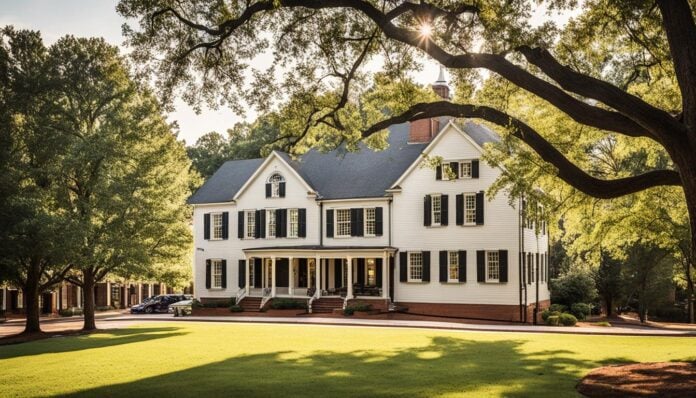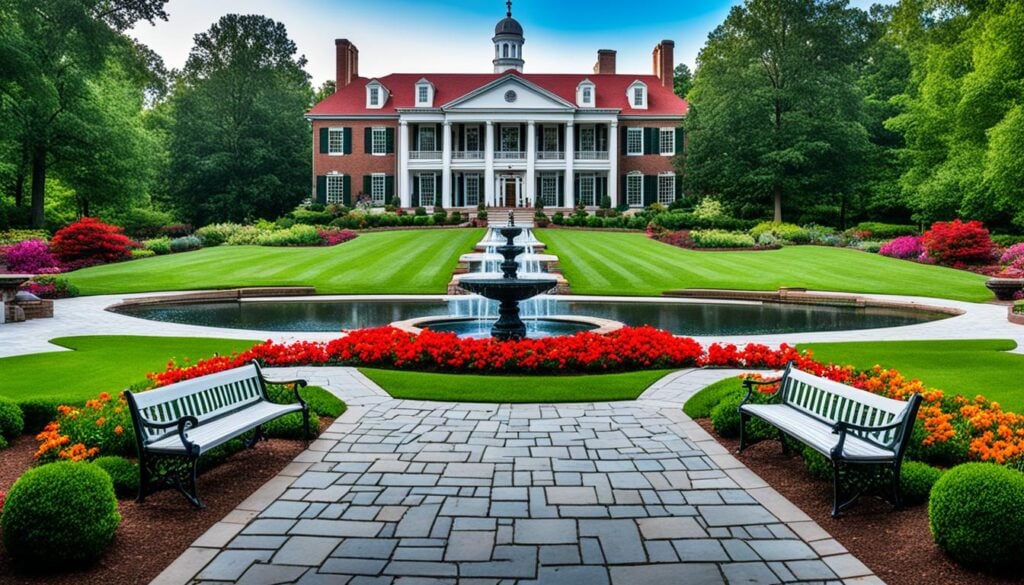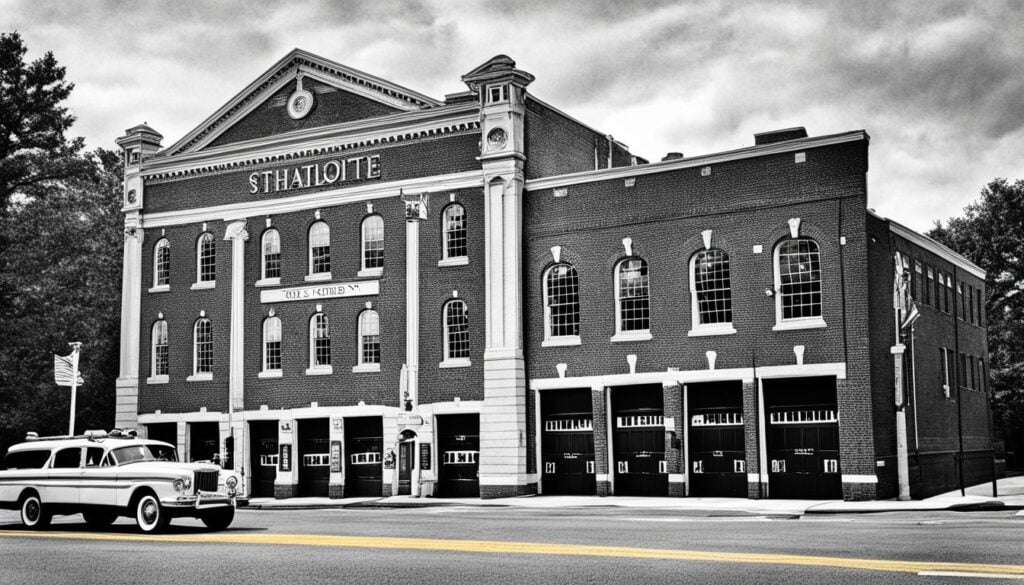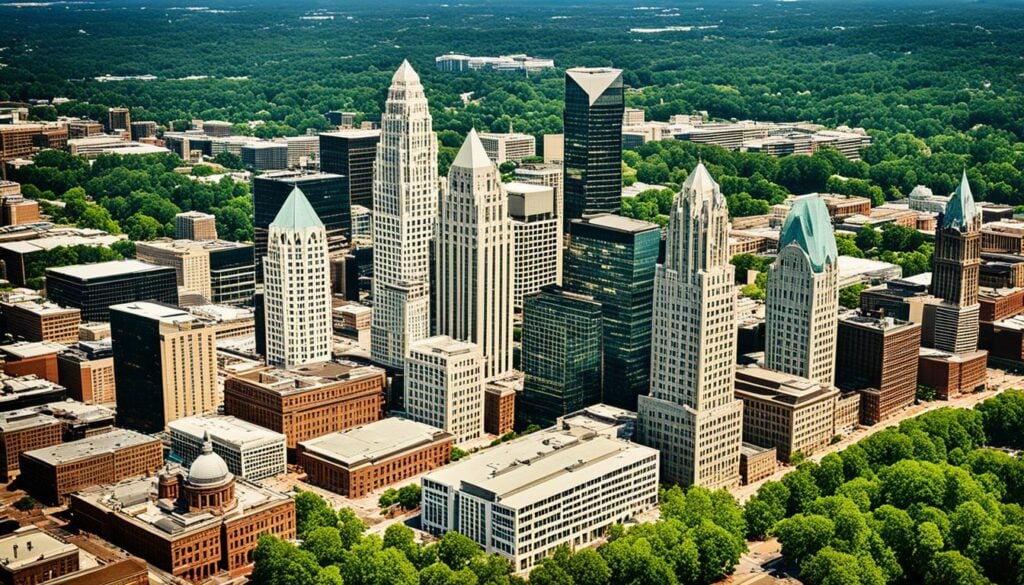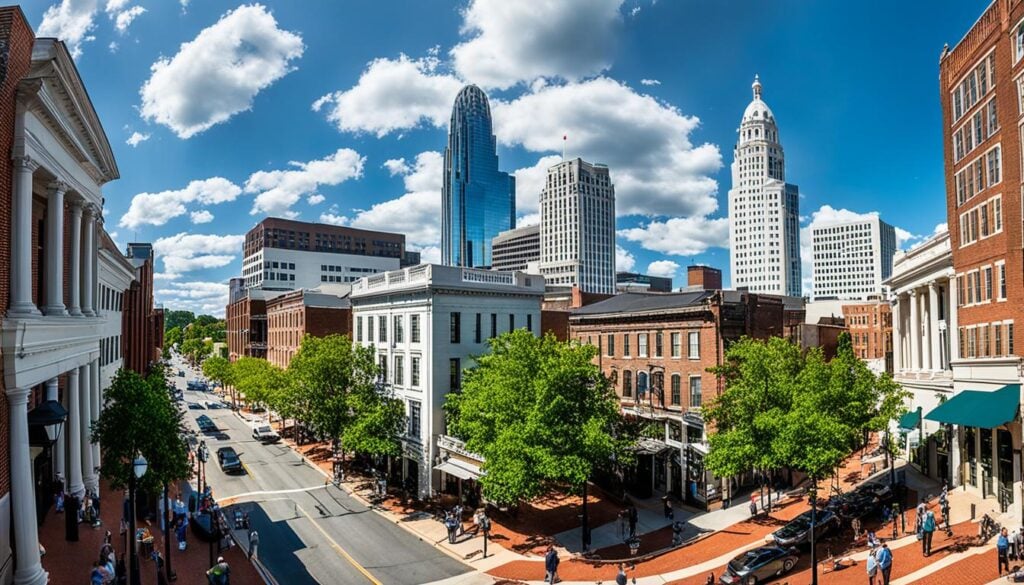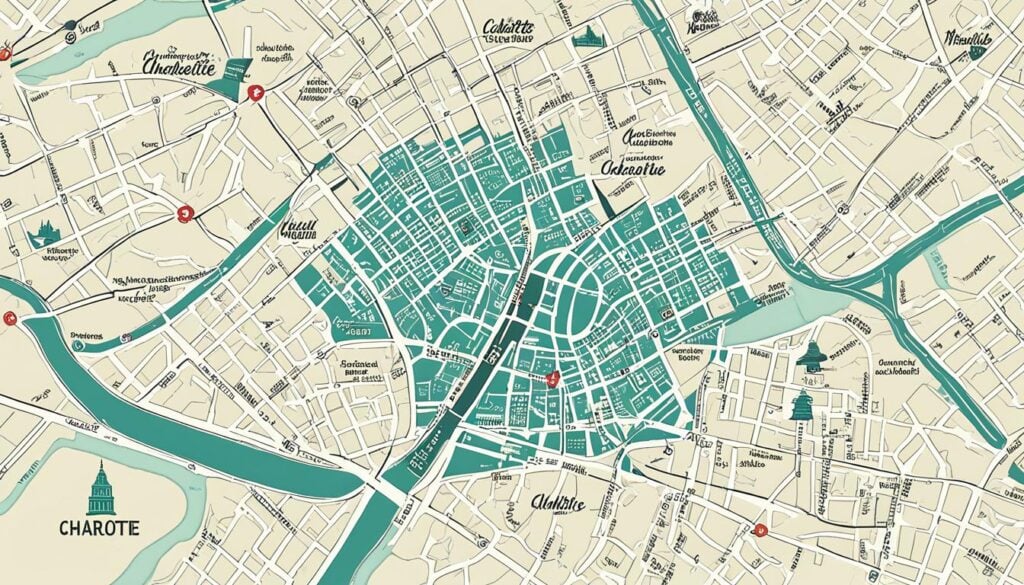Have you ever thought about how a city changes yet keeps its history? Charlotte, North Carolina, is a perfect example of this mix. It has grown from a trading post to a big city, keeping its historic sites along the way.
Exploring Charlotte’s historic landmarks takes you back in time. You’ll see how the city has changed over the years. Each site tells a story, showing the city’s vibrant culture.
Charlotte’s historical places are full of hidden stories. Each spot has its own tales, waiting for you to discover them. It’s a journey through time, right in the heart of the city.
Introduction to Charlotte’s Rich History
Charlotte has a long history that goes back to the 18th century. It became a key place during the gold rush. Named after Queen Charlotte, the wife of King George III of England, it has grown into a city with a strong identity.
Its history is full of important events like the American Civil War and the Civil Rights Movement. These events have deeply influenced Charlotte’s culture and landscape. Taking Charlotte history tours lets you see how these events still shape the city today.
What Historical Sites Can I Visit in Charlotte?
Charlotte is full of historical sites that show off its rich heritage. If you’re asking, “What historical sites can I visit in Charlotte?”, you’ll find many places that tell the city’s story. You can explore charming neighborhoods or dive into museums to learn about Charlotte’s history.
Top Historical Landmarks
The Historic Fourth Ward is the oldest neighborhood in Charlotte, known for its Victorian-era buildings. Don’t miss the Charlotte Museum of History, where you can see regional artifacts and hear their stories. Use the Charlotte NC historical sites map to find the best spots and discover hidden treasures.
Unique Historical Experiences
Look for live reenactments or guided tours to connect with Charlotte’s history. The Levine Museum of the New South has interactive exhibits on post-Civil War Southern history. These activities not only deepen your knowledge but also give you a lasting impression of Charlotte’s history.
Must-See Historical Attractions in Charlotte
Exploring Charlotte’s historical spots is a great way to learn about its past. You can choose from guided tours or go on your own. The city’s landmarks tell stories of its lively history, making it perfect for history buffs.
Guided Tours of Historic Sites
Charlotte history tours take you deep into the city’s past. You’ll see places like the First Presbyterian Church, known for its beautiful Gothic Revival style. Guides share interesting stories and facts, making history come alive.
Self-Guided Tours and Maps
For those who like to explore at their own pace, self-guided tours are a great choice. These tours come with maps that lead you to important historical spots. At each stop, you’ll find information to help you understand the area better. This lets you see Charlotte’s historical sites on your own terms.
| Type of Tour | Description | Recommended Locations |
|---|---|---|
| Guided Tours | Led by knowledgeable guides, covering key landmarks. | First Presbyterian Church, Charlotte Museum of History |
| Self-Guided Tours | Maps provided for personalized exploration. | Independence Hall, Historic West End |
Overview of Historic Landmarks in Charlotte, NC
Charlotte’s historic landmarks show off the city’s lively past. Every corner reveals a bit of history that makes the area special. The Old Mecklenburg County Courthouse from 1820 is a key example. It stands as a symbol of Charlotte’s early days and is known for its Federal style.
The City Hall is another important landmark. It blends modern design with the old, offering a unique look at Charlotte’s growth. This mix of old and new architecture is truly captivating.
Efforts to preserve these landmarks are vital. They help make sure future generations can learn about Charlotte’s history. Exploring these sites with a guided tour deepens your understanding of Charlotte’s heritage. It also links you to American history.

Exploring Charlotte’s Historical District
When you step into Charlotte’s historical district, you find yourself surrounded by rich heritage and stunning architecture. Neighborhoods like Dilworth and the Fourth Ward are full of history. They show you the city’s past through beautiful homes that tell their own stories. The mix of architectural styles in Charlotte makes this journey even more interesting, telling the story of the city’s growth over time.
Key Areas to Visit
- Dilworth: Known for its charming streets and tree-lined avenues, this neighborhood features stunning examples of Arts and Crafts and Colonial Revival styles.
- Fourth Ward: This area boasts a remarkable collection of Victorian homes, reflecting the grandeur of the late 19th century and the city’s expansion.
- Uptown Charlotte: A blend of modern and historic architecture, this district highlights how contemporary designs coexist with notable historical structures.
Architectural Styles and Heritage
In Charlotte’s historical district, you’ll see many architectural styles that reflect the city’s cultural history. From the detailed Romanesque Revival to the simple Minimalist designs, each building adds to the area’s look and story. The mix of styles lets you see the skill and the history behind each home. Walking through these areas gives you a deep look at Charlotte’s historical value.
| Architectural Style | Characteristics | Example Neighborhoods |
|---|---|---|
| Victorian | Intricate designs, vibrant colors, ornate details | Fourth Ward |
| Greek Revival | Symmetrical shape, tall columns, heavy cornices | Dilworth |
| Arts and Crafts | Natural materials, handcrafted details, simplicity | Dilworth |
| Colonial Revival | Classic proportions, gable roofs, and brick facades | Uptown Charlotte |
Top Charlotte Museums with History Exhibits
Charlotte’s museums are full of history and culture. They let visitors dive into the city’s past through stories and artifacts. The Mint Museum, in a former U.S. Mint building, has art and historical items. It shows how Charlotte’s art and culture have changed over time.
The NASCAR Hall of Fame is another key spot. It’s all about auto racing and Charlotte’s big part in it. You can touch and learn about racing legends and the tech behind it.
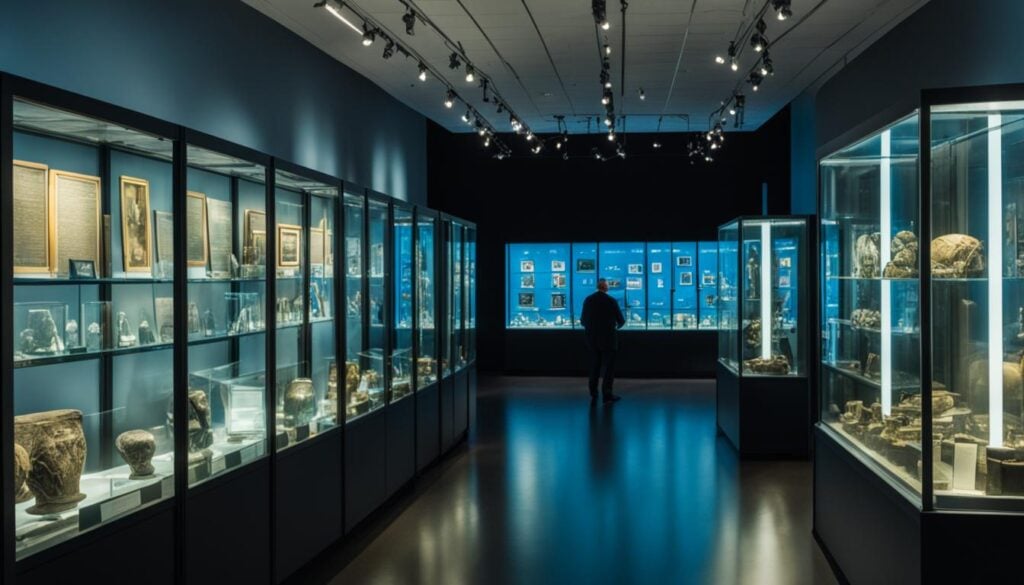
Other museums like the Levine Museum of the New South focus on the South after the Civil War. They use multimedia to tell stories of big changes in society and the economy.
These museums are key to keeping Charlotte’s history alive for everyone. Each one shares a special story, linking the past to the present.
Notable Historical Buildings in Charlotte
Charlotte is home to many historical buildings that show the city’s deep history. These landmarks are kept safe thanks to preservation efforts. This lets us see the past and enjoy their beauty. Groups work hard to keep these buildings open for everyone and use them for learning.
Preservation Efforts in the City
Many groups work together to save and fix historical buildings in Charlotte. They rely on the community and donations to do this. Places like Latta Plantation and Biddle Memorial Hall show how well this works. These buildings add to the city’s culture and help us understand its growth.
Visitor Information for Historical Buildings
Before you visit Charlotte’s historical buildings, check their hours. Guided tours can give you new insights and make your visit better. You can find all the details you need on the websites or a Charlotte NC historical sites map. This makes planning your trip easier and more fun.
Insider Tips for Visiting Historical Sites
Planning your visit to Charlotte’s historical places can make a big difference. Knowing the best times to go and where to park can make exploring the city’s history easier. This way, you can dive deeper into the city’s past.
Best Times to Visit
Visit during off-peak seasons to avoid crowds and enjoy a more personal experience. Try going on weekdays or early mornings when it’s quieter. Also, watch for special events that might change how you can access certain sites.
Parking and Accessibility Options
Keep an eye on parking when you visit Charlotte’s historical spots. Do some research on parking options beforehand to avoid any trouble. Many sites have their own parking, but knowing the local parking rules is helpful.
Accessibility is key. Many places have facilities for visitors with disabilities. This makes sure everyone can enjoy Charlotte’s history.
Charlotte’s Historical Locations on a Map
Exploring Charlotte’s history gets better with a Charlotte NC historical sites map. This map guides you to famous spots and hidden treasures in the city. You can find online and printable maps that help you navigate Charlotte’s historical sites.
A detailed Charlotte NC historical sites map highlights important places like:
- The Levine Museum of the New South
- The Historic Rosedale Plantation
- The Charlotte Museum of History
- The Wyatt Pavilion at UNCC
Using a map lets you visit Charlotte’s historical spots in order. It also shows you less known places, giving you a deeper look at the city’s history. This way, you appreciate Charlotte’s story more deeply.
Conclusion
Exploring historic sites in Charlotte opens a door to a rich story that shapes the city’s identity. You’ll find iconic landmarks and museums that tell Charlotte’s story. Each visit lets you connect with the past.
Use the tips from this article to make your visit better. You can join guided tours or explore on your own. This way, you can learn about Charlotte’s history at your pace. Every corner of the city has a story.
If you live in Charlotte or are just visiting, don’t miss out on exploring its historic sites. Plan now to see the lasting legacy and vibrant culture of Charlotte. It’s a place where history meets the present, for everyone to enjoy.

































